Evidence of Allelopathy among Selected Moss Species with Lettuce and Radish
Abstract
1. Introduction
2. Materials and Methods
2.1. Plant Material
2.2. Experimental Design
2.2.1. Preparation of the Moss Extracts
2.2.2. Testing the Allelopathic Potential of the Moss Extracts
2.2.3. Analysis of the Total Chlorophyll Concentration
2.3. Statistical Analysis
3. Results
3.1. The Effects of the Moss Extracts on the Lettuce Seed Germination
3.2. The Effects of the Moss Extracts on the Radish Seed Germination
3.3. The Effect of the Moss Extracts on the Lettuce Seedling Hypocotyl Length
3.4. The Effect of the Moss Extracts on the Total Chlorophyll Concentration of the Lettuce Seedlings
3.5. The Effect of the Moss Extracts on the Radish Seedling Hypocotyl Length
3.6. The Effect of the Moss Extracts on the Total Chlorophyll Concentration of the Radish Seedlings
4. Discussion
4.1. The Effect of the Moss Extracts on Tested Vegetable Seed Germination
4.2. The Effect of the Moss Extracts on Tested Vegetable Hypocotyl Length
4.3. The Total Chlorophyll Content Is Rather Unstable under Moss Extract Treatments
5. Conclusions
Author Contributions
Funding
Institutional Review Board Statement
Data Availability Statement
Conflicts of Interest
References
- Gniazdowska, A.; Bogatek, R. Allelopathic interactions between plants. Multi site action of allelochemicals. Acta Physiol. Plant. 2005, 27, 395–407. [Google Scholar] [CrossRef]
- Rice, E.L. Allelopathy, 2nd ed.; Academic Press Inc.: Orlando, FL, USA, 1984; p. 424. [Google Scholar]
- Soltys, D.; Krasuska, U.; Bogatek, R.; Gniazdowska, A. Allelochemicals as bioherbicides—Present and perspectives. In Herbicides-Current Research and Case Studies in Use; Price, A.J., Kelton, J.A., Eds.; IntechOpen: London, UK, 2013; pp. 517–542. [Google Scholar]
- Asakawa, Y.; Ludwiczuk, A.; Nagashima, F. Phytochemical and biological studies of bryophytes. Phytochemistry 2013, 91, 52–80. [Google Scholar] [CrossRef] [PubMed]
- Asakawa, Y.; Ludwiczuk, A.; Nagashima, F. Chemical Constituents of Bryophyte, 1st ed.; Springer: Vienna, Austria, 2013; pp. 563–605. [Google Scholar]
- Sabovljević, M.S.; Sabovljević, A.D.; Ikram, N.K.K.; Peramuna, A.; Bae, H.; Simonsen, H.T. Bryophytes—An emerging source for herbal remedies and chemical production. Plant Genet. Res. 2016, 14, 314–327. [Google Scholar] [CrossRef]
- Xie, C.; Lou, H. Secondary metabolites in bryophytes: An ecological aspect. Chem. Biodivers. 2009, 6, 303–312. [Google Scholar] [CrossRef] [PubMed]
- Ćosić, M.V.; Mišić, D.M.; Jakovljević, K.M.; Giba, Z.S.; Sabovljević, A.D.; Sabovljević, M.S.; Vujičić, M.M. The selected moss analyses of quantitative and qualitative content of phenolic compounds under NaCl stress. Molecules 2023, 28, 1794. [Google Scholar] [CrossRef] [PubMed]
- Willis, R.J. The History of Allelopathy; Springer Science & Business Media: Dordrecht, The Netherlands, 2007. [Google Scholar]
- Whitehead, J.; Wittemann, M.; Cronberg, N. Allelopathy in bryophytes—A review. Lindbergia 2018, 41, 1–7. [Google Scholar] [CrossRef]
- Chen, F.; Ludwiczuk, A.; Wei, G.; Chen, X.; Crandall-Stotler, B.; Bowman, J.L. Terpenoid secondary metabolites in bryophytes: Chemical diversity, biosynthesis and biological functions. Crit. Rev. Plant Sci. 2018, 37, 210–231. [Google Scholar] [CrossRef]
- Kulshrestha, S.; Jibran, R.; Van Klink, J.W.; Zhou, Y.; Brummell, D.A.; Albert, N.W.; Schwinn, K.E.; Changé, D.; Landi, M.; Bowman, J.L.; et al. Stress, senescence, and specialized metabolites in bryophytes. J. Exp. Bot. 2022, 73, 4396–4411. [Google Scholar] [CrossRef]
- Harris, E.S. Ethnobryology: Traditional uses and folk classification of bryophytes. Bryologist 2008, 111, 169–217. [Google Scholar] [CrossRef]
- Mandić, M.R.; Oaldje, M.M.; Lunić, T.; Sabovljević, A.D.; Sabovljević, M.S.; Gašić, U.M.; Duletić-Laušević, S.N.; Božić, B.D.; Božić Nedeljković, B.D. Chemical characterization and in vitro immunomodulatory effects of different extracts of moss Hedwigia ciliata (Hedw.) P. Beauv. from the Vršačke Planine Mts., Serbia. PLoS ONE 2021, 16, e0246810. [Google Scholar] [CrossRef]
- Drobnik, J.; Stebel, A. Four centuries of medicinal mosses and liverworts in European ethnopharmacy and scientific pharmacy: A review. Plants 2021, 10, 1296. [Google Scholar] [CrossRef] [PubMed]
- Newton, A.E.; Mishler, B.D. The evolutionary significance of asexual reproduction in mosses. J. Hattori Bot. Lab. 1994, 76, 127–145. [Google Scholar]
- Vicherová, E.; Glinwood, R.; Hájek, T.; Šmilauer, P.; Ninkovic, V. Bryophytes can recognize their neighbours through volatile organic compounds. Sci. Rep. 2020, 10, 7405. [Google Scholar] [CrossRef] [PubMed]
- Löbel, S.; Dengler, J.; Hobohm, C. Species richness of vascular plants, bryophytes and lichens in dry grasslands: The effects of environment, landscape structure and competition. Folia Geobot. 2006, 41, 377–393. [Google Scholar] [CrossRef]
- Frahm, J.P.; Risse, S.; Saan-Klein, B.V. Are bryophytes extracts inhibiting or promoting seed growth? Arch. Bryol. 2012, 127, 1–10. [Google Scholar]
- Wang, Q.; Zhao, C.; Gao, Y.; Gao, C.; Qiao, Y.; Xie, H.; Wang, W.; Yuan, L.; Liu, J.; Ma, W.; et al. Effects of Abietinella abietina extracts on the germination and seedling emergence of Picea crassifolia: Results of greenhouse experiments. Pol. J. Ecol. 2016, 64, 357–368. [Google Scholar]
- Huneck, S.; Meinunger, L. Plant growth regulatory activities of bryophytes: A contribution to the chemical ecology of mosses and liverworts. Bryophytes, their chemistry and chemical taxonomy. Proc. Phytochem. Soc. Eur. 1990, 29, 289–298. [Google Scholar]
- Kato-Noguchi, H. Allelopathic chemical interaction of bryophytes with vascular plants. Mini Rev. Org. Chem. 2016, 13, 422–429. [Google Scholar] [CrossRef]
- Kobayashi, K.; Shigemori, H. Allelopathy of the moss Hypnum plumaeforme by the production of momilactone A and B. Weed Res. 2009, 49, 621–627. [Google Scholar]
- Kato-Noguchi, H.; Seki, T. Allelopathy of the moss Rhynchstegium pallidifolium and 3-hydroxy-β-ionene. Plant Signal. Behav. 2010, 5, 702–704. [Google Scholar] [CrossRef][Green Version]
- Kato-Noguchi, H.; Seki, T.; Shigemori, H. Allelopathy and allelopathic substance in the moss Rhynchostegium pallidifolium. J. Plant Physiol. 2010, 167, 468–471. [Google Scholar] [CrossRef] [PubMed]
- Lichtenthaler, H.K. Chlorophylls and Carotenoids: Pigments of Photosynthetic Biomembranes. Methods Enzymol. 1987, 148, 350–382. [Google Scholar]
- R Core Team, R. A Language and Environment for Statistical Computing; R Foundation for Statistical Computing: Vienna, Austria, 2022; Available online: https://www.R-project.org/ (accessed on 25 December 2023).
- Agresti, A. An Introduction to Categorical Data Analysis, 2nd ed.; Wiley: Hoboken, NJ, USA, 2007. [Google Scholar]
- Wobbrock, J.O.; Findlater, L.; Gergle, D.; Higgins, J.J. The aligned rank transform for nonparametric factorial analyses using only ANOVA procedures. In Proceedings of the ACM Conference on Human Factors in Computing Systems (CHI 2011), Vancouver, BC, Canada, 7–12 May 2011; ACM Press: New York, USA, 2011; pp. 143–146. [Google Scholar]
- Elkin, L.A.; Kay, M.; Higgins, J.J.; Wobbrock, J.O. An aligned rank transform procedure for multifactor contrast tests. In Proceedings of the 34th Annual ACM Symposium on User Interface Software and Technology, Virtual, 10–14 October 2021; Nichols, J., Kumar, R., Bebeling, M., Eds.; Association for Computing Machinery: New York, NY, USA, 2021. [Google Scholar]
- Kay, M.; Elkin, L.A.; Higgins, J.J.; Wobbrock, J.O. mjskay/ARTool: ARTool 0.11.0 (v0.11.0). Zenodo. 2021. Available online: https://zenodo.org/records/4721941 (accessed on 7 January 2024). [CrossRef]
- Michel, P.; Burritt, D.J.; Lee, W.G. Bryophytes display allelopathic interactions with tree species in native forest ecosystems. Oikos 2011, 120, 1272–1280. [Google Scholar] [CrossRef]
- Thakur, S.; Kapila, S. Allelopathic effect of some liverworts on seed germination of the weed Bidens pilosa L. Int. J. Pharm. Sci. Rev. Res. 2015, 32, 77–80. [Google Scholar]
- Bhadauriya, G.; Singh, S.; Srivastava, K. Promoting and inhibiting effects of bryophyte extracts on the seed germination and seedling growth of Vigna radiata and Cicer arietinum. Biol. Forum 2016, 8, 410–416. [Google Scholar]
- Tsubota, H.; Kuroda, A.; Masuzaki, H. Preliminary study on allelopathic activity of bryophytes under laboratory conditions using the sandwich method. J. Hattori Bot. Lab. 2006, 100, 395–409. [Google Scholar]
- Frahm, J.P.; Kirchhoff, K. Antifeeding effects of bryophyte extracts from Neckera crispa and Porella obtusata against the slug Arion lusitanicus. Cryptogam. Bryol. 2002, 23, 271–275. [Google Scholar]
- Rempt, M.; Pohnert, G. Novel acetylenic oxylipins from the moss Dicranum scoparium with antifeeding activity against herbivorous slugs. Angew. Chem. Int. Ed. Engl. 2010, 49, 4755–4758. [Google Scholar] [CrossRef]
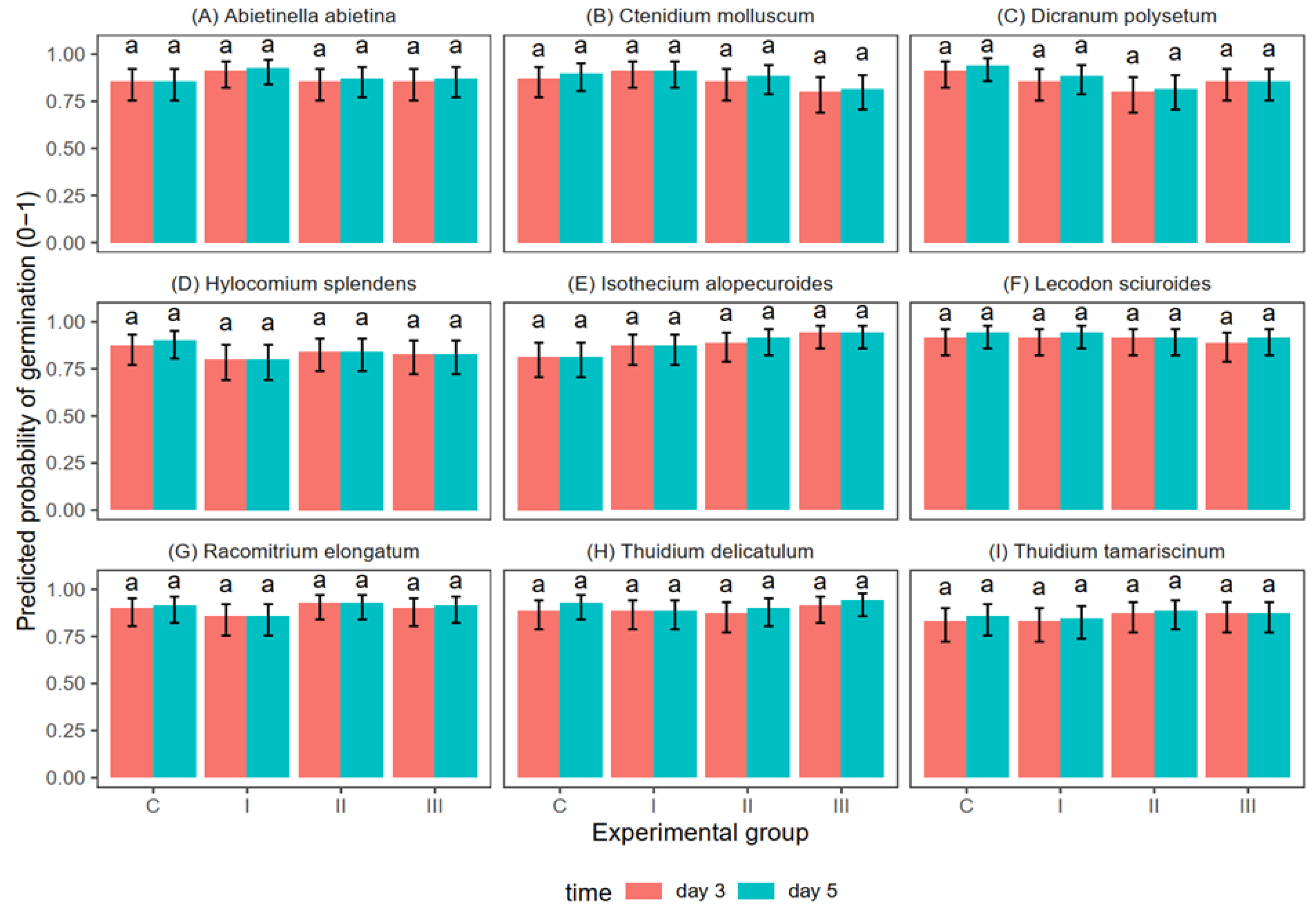
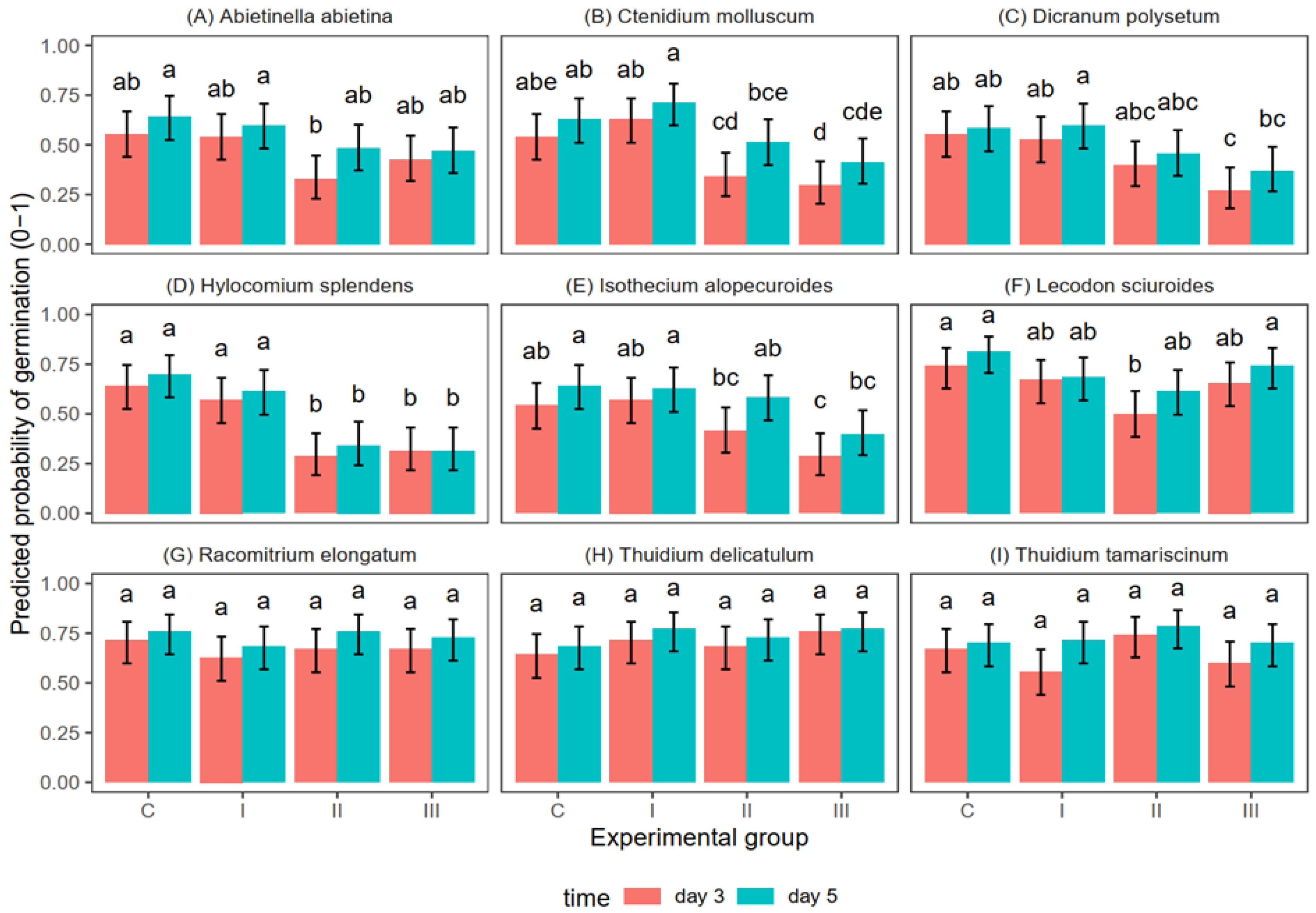
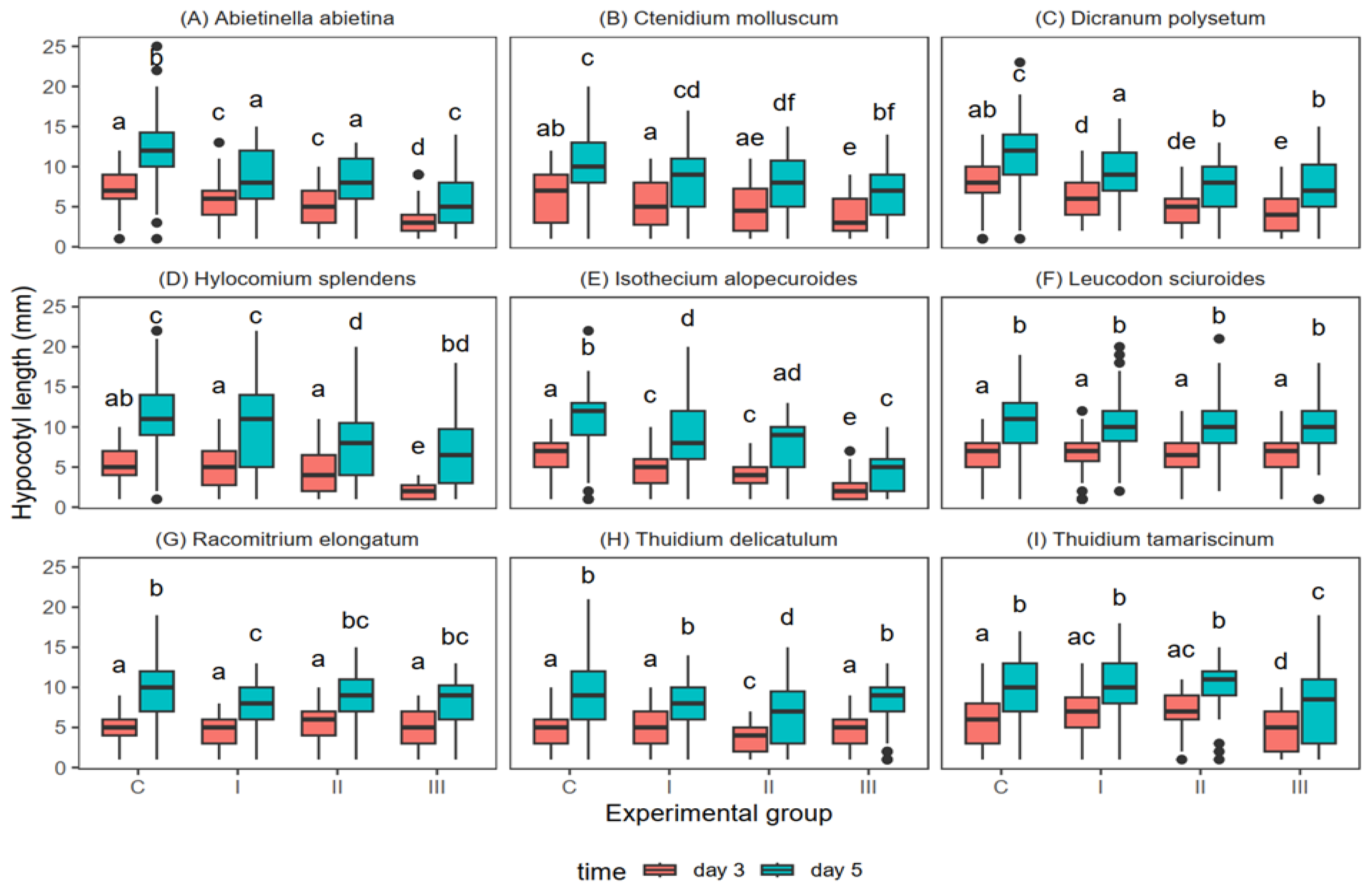
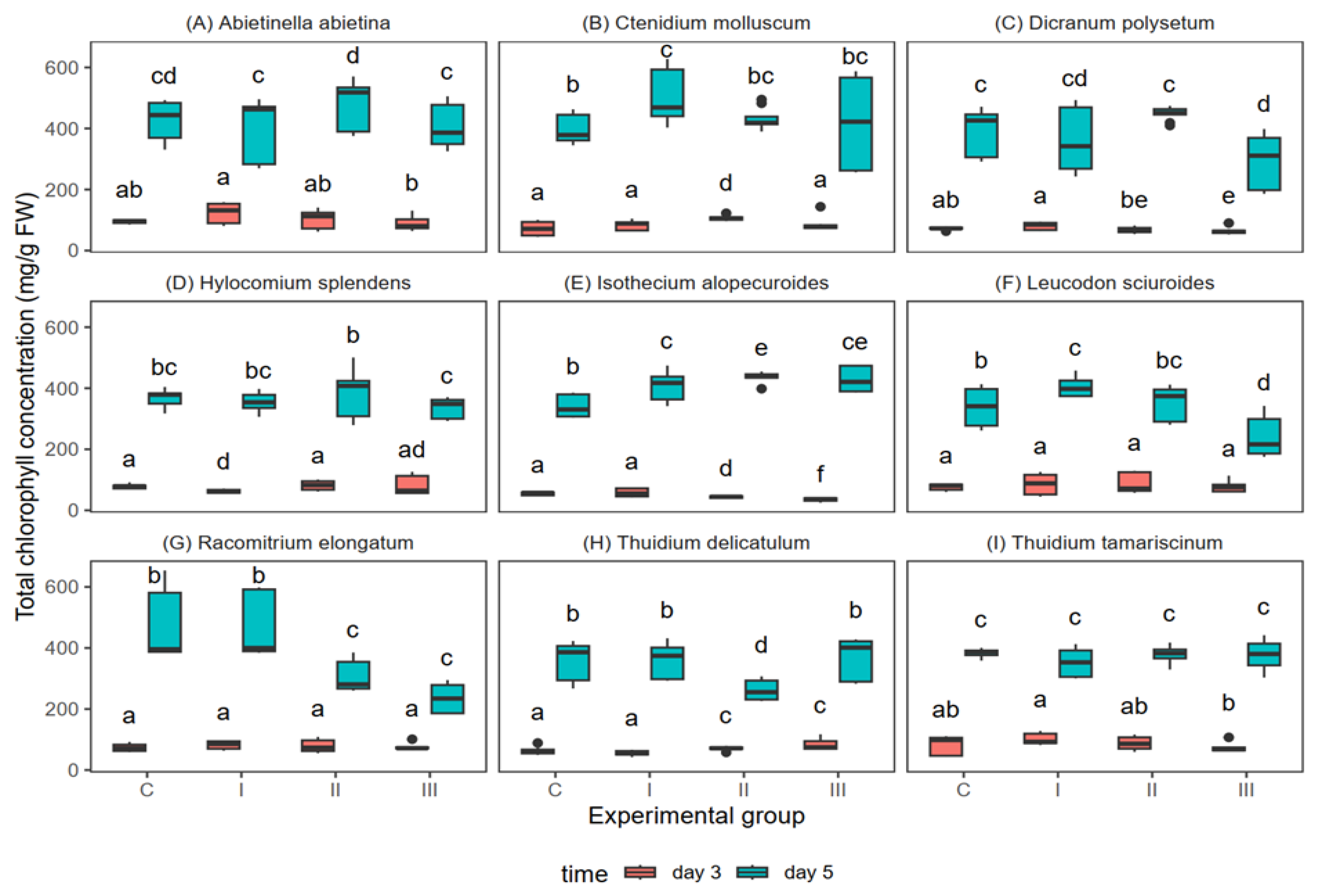
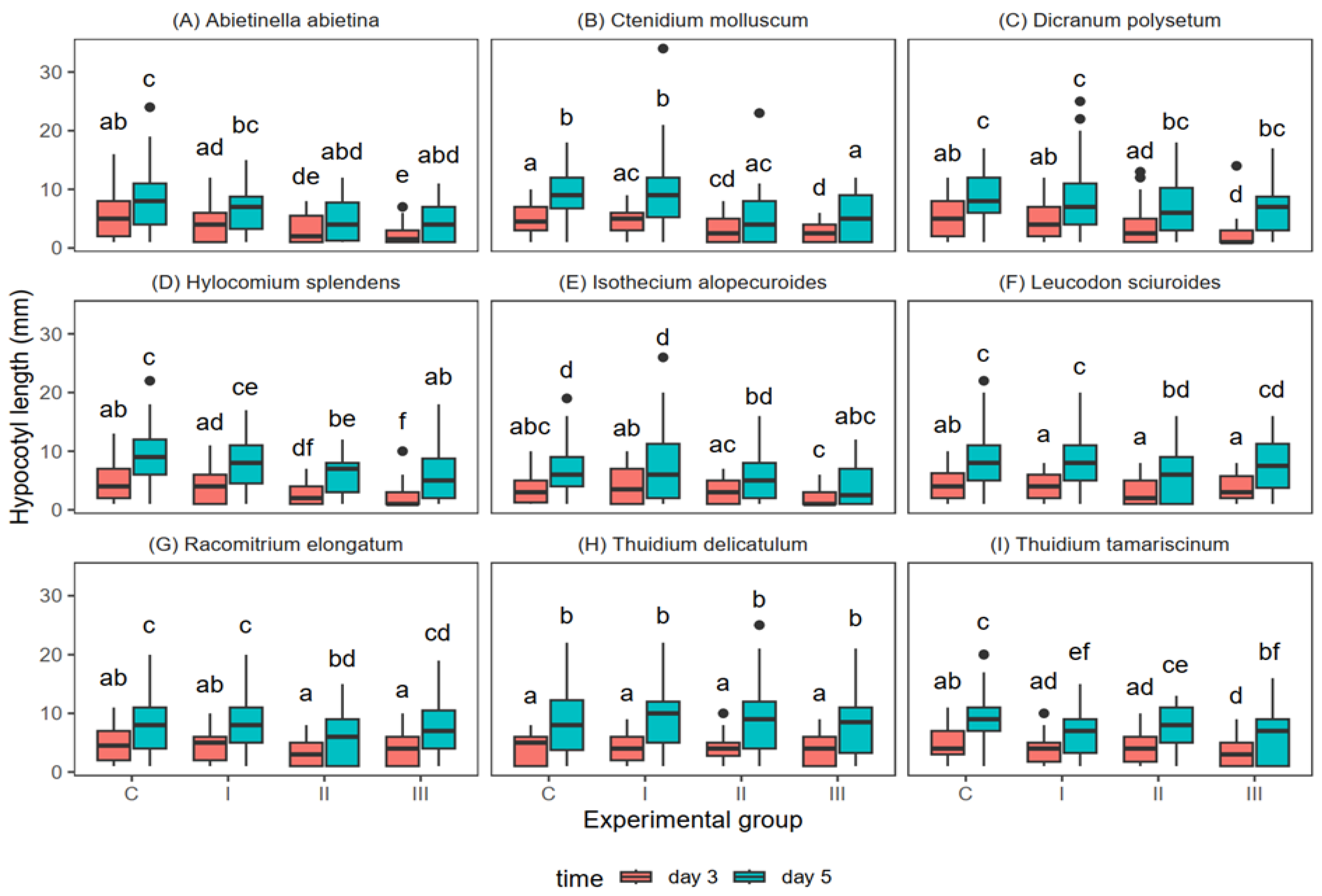
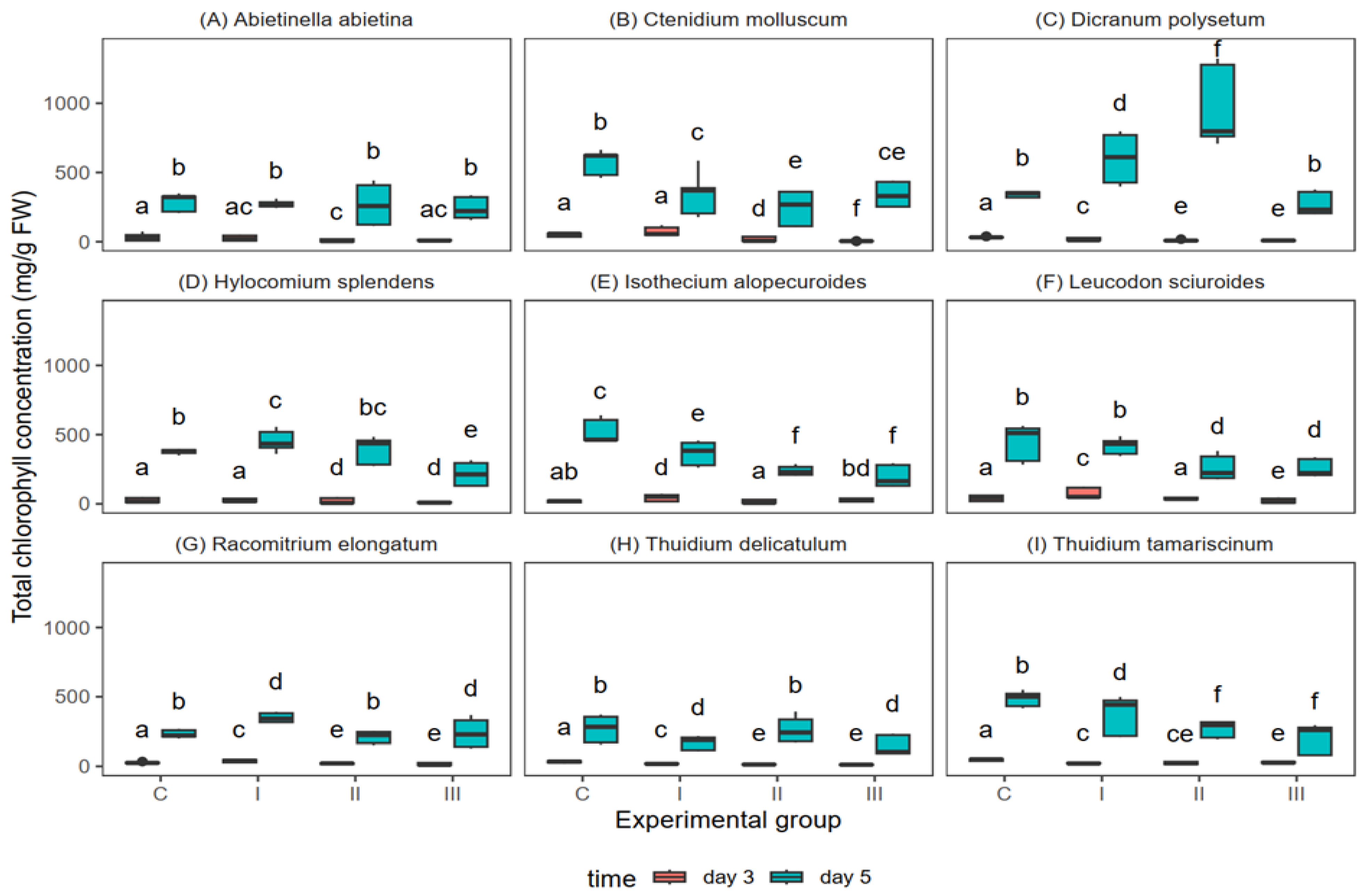
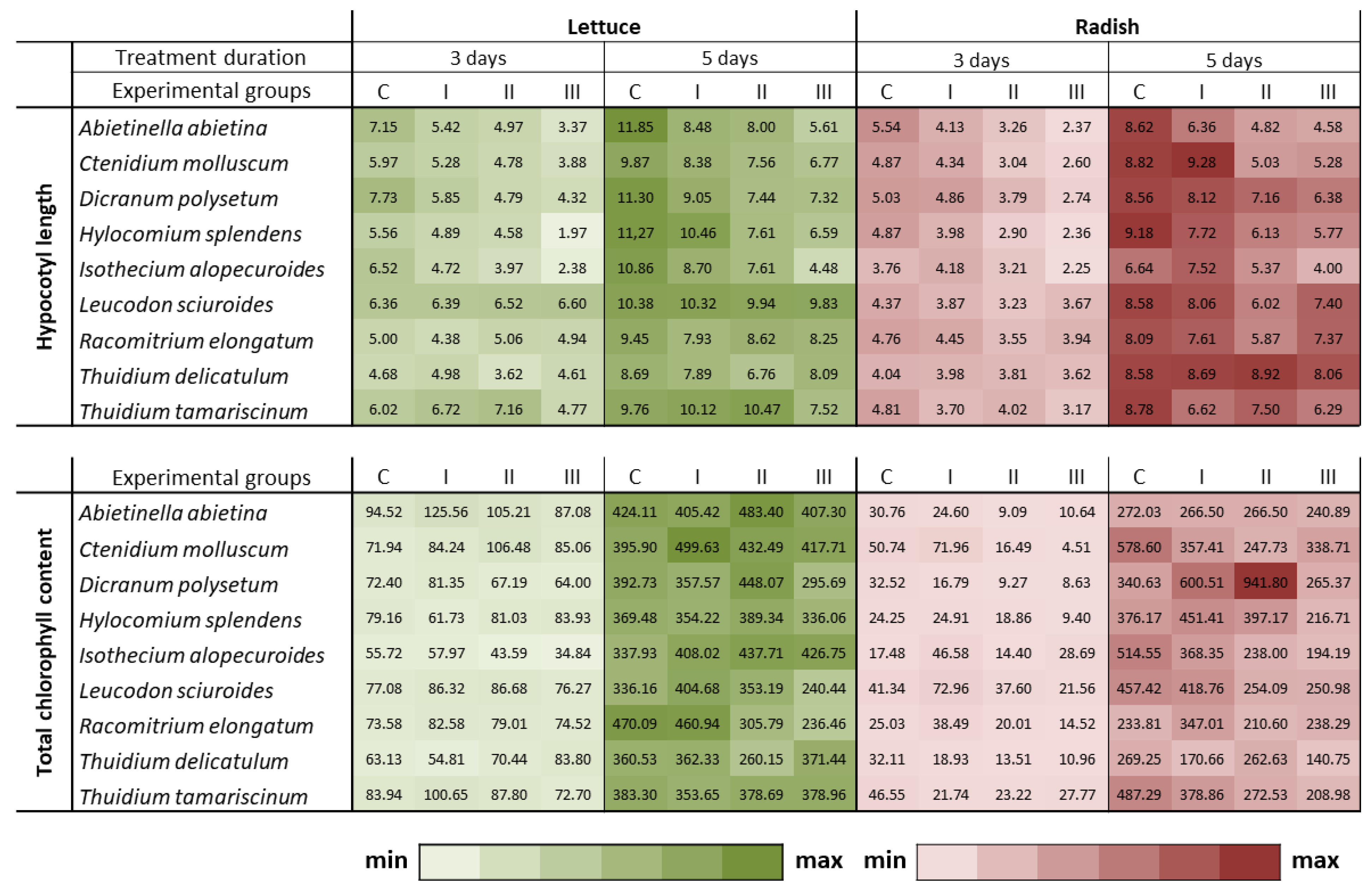
| Species | Parameter | (Intercept) | C [I] | C [II] | C [III] | T [5] | C [I] × T [5] | C [II] × T [5] | C [III] × T [5] | Observation | R2 Tjur |
|---|---|---|---|---|---|---|---|---|---|---|---|
| Abietinella abietina | Odds ratios | 6.00 *** | 1.78 | 1.00 | 1.00 | 1.00 | 1.22 | 1.13 | 1.13 | 560 | 0.007 |
| p | <0.001 | 0.293 | 1.00 | 1.00 | 1.00 | 0.803 | 0.860 | 0.860 | |||
| Ctenidium molluscum | Odds ratios | 6.78 *** | 1.57 | 0.89 | 0.59 | 1.33 | 0.75 | 0.97 | 0.83 | 560 | 0.015 |
| p | <0.001 | 0.415 | 0.805 | 0.257 | 0.596 | 0.725 | 0.970 | 0.780 | |||
| Dicranum polysetum | Odds ratios | 10.67 *** | 0.56 | 0.38 | 0.56 | 1.55 | 0.84 | 0.71 | 0.65 | 560 | 0.017 |
| p | <0.001 | 0.293 | 0.060 | 0.293 | 0.514 | 0.830 | 0.665 | 0.597 | |||
| Hylocomnium splendens | Odds ratios | 6.78 *** | 0.59 | 0.79 | 0.71 | 1.33 | 0.75 | 0.75 | 0.75 | 560 | 0.007 |
| p | <0.001 | 0.257 | 0.630 | 0.479 | 0.596 | 0.677 | 0.689 | 0.685 | |||
| Isothecium alopecuroides | Odds ratios | 4.38 *** | 1.55 | 1.77 | 3.76 * | 1.00 | 1.00 | 1.38 | 1.00 | 560 | 0.021 |
| p | <0.001 | 0.355 | 0.241 | 0.027 | 1.000 | 1.000 | 0.655 | 1.000 | |||
| Leucodon sciuroides | Odds ratios | 10.67 *** | 1.00 | 1.00 | 0.73 | 1.55 | 1.00 | 0.65 | 0.89 | 560 | 0.004 |
| p | <0.001 | 1.000 | 1.000 | 0.574 | 0.514 | 1.000 | 0.628 | 0.894 | |||
| Racomitrium elongatum | Odds ratios | 9.00 *** | 0.67 | 1.44 | 1.00 | 1.19 | 0.84 | 0.84 | 1.00 | 560 | 0.008 |
| p | <0.001 | 0.440 | 0.548 | 1.000 | 0.771 | 0.823 | 0.847 | 1.000 | |||
| Thuidium delicatulum | Odds ratios | 7.75 *** | 1.00 | 0.87 | 1.38 | 1.68 | 0.60 | 0.79 | 0.92 | 560 | 0.006 |
| p | <0.001 | 1.000 | 0.796 | 0.574 | 0.386 | 0.518 | 0.771 | 0.928 | |||
| Thuidium tamariscinum | Odds ratios | 4.83 *** | 1.00 | 1.40 | 1.40 | 1.24 | 0.89 | 0.92 | 0.81 | 560 | 0.003 |
| p | <0.001 | 1.000 | 0.479 | 0.479 | 0.643 | 0.864 | 0.906 | 0.753 |
| Species | Parameter | (Intercept) | C [I] | C [II] | C [III] | T [5] | C [I] × T [5] | C [II] × T [5] | C [III] × T [5] | Observation | R2 Tjur |
|---|---|---|---|---|---|---|---|---|---|---|---|
| Abietinella abietina | Odds ratios | 1.26 | 0.94 | 0.39 ** | 0.60 | 1.43 | 0.88 | 1.35 | 0.83 | 560 | 0.035 |
| p | 0.340 | 0.865 | 0.007 | 0.129 | 0.301 | 0.798 | 0.543 | 0.703 | |||
| Ctenidium molluscum | Odds ratios | 1.19 | 1.43 | 0.44 * | 0.36 ** | 1.43 | 1.04 | 1.42 | 1.16 | 560 | 0.076 |
| p | 0.474 | 0.304 | 0.018 | 0.004 | 0.304 | 0.943 | 0.470 | 0.767 | |||
| Dicranum polysetum | Odds ratios | 1.26 | 0.89 | 0.53 | 0.30 *** | 1.12 | 1.19 | 1.12 | 1.41 | 560 | 0.048 |
| p | 0.340 | 0.734 | 0.064 | 0.001 | 0.733 | 0.718 | 0.809 | 0.491 | |||
| Hylocomnium splendens | Odds ratios | 1.80 * | 0.74 | 0.22 *** | 0.25 *** | 1.30 | 0.92 | 1.01 | 0.77 | 560 | 0.107 |
| p | 0.018 | 0.387 | <0.001 | <0.001 | 0.472 | 0.870 | 0.990 | 0.613 | |||
| Isothecium alopecuroides | Odds ratios | 1.19 | 1.12 | 0.60 | 0.34 ** | 1.52 | 0.84 | 1.32 | 1.10 | 560 | 0.057 |
| p | 0.474 | 0.734 | 0.129 | 0.002 | 0.229 | 0.717 | 0.570 | 0.849 | |||
| Leucodon sciuroides | Odds ratios | 2.89 *** | 0.71 | 0.35 ** | 0.66 | 1.52 | 0.70 | 1.05 | 0.99 | 560 | 0.036 |
| p | <0.001 | 0.354 | 0.003 | 0.270 | 0.311 | 0.521 | 0.928 | 0.990 | |||
| Racomitrium elongatum | Odds ratios | 2.50 *** | 0.68 | 0.82 | 0.82 | 1.25 | 1.03 | 1.22 | 1.05 | 560 | 0.009 |
| p | 0.001 | 0.281 | 0.583 | 0.583 | 0.566 | 0.949 | 0.708 | 0.922 | |||
| Thuidium delicatulum | Odds ratios | 1.80 * | 1.39 | 1.21 | 1.73 | 1.21 | 1.11 | 1.01 | 0.89 | 560 | 0.009 |
| p | 0.018 | 0.366 | 0.592 | 0.142 | 0.592 | 0.839 | 0.977 | 0.833 | |||
| Thuidium tamariscinum | Odds ratios | 2.04 ** | 0.62 | 1.41 | 0.73 | 1.14 | 1.74 | 1.11 | 1.36 | 560 | 0.022 |
| p | 0.005 | 0.166 | 0.354 | 0.380 | 0.716 | 0.278 | 0.845 | 0.545 |
| Species | Parameter | C | T | C × T |
|---|---|---|---|---|
| Abietinella abietina | Hypocotyl length | 51.995 *** | 131.77 *** | 3.6807 * |
| Total Chl | 2.5974 | 194.98 *** | 1.6675 | |
| Ctenidium molluscum | Hypocotyl length | 10.428 *** | 91.365 *** | 0.3476 |
| Total Chl | 5.9260 ** | 197.28 *** | 4.6742 ** | |
| Dicranum polysetum | Hypocotyl length | 31.86 *** | 109.3 *** | 0.152 |
| Total Chl | 9.8232 *** | 193.99 *** | 10.399 *** | |
| Hylocomium splendens | Hypocotyl length | 34.266 *** | 193.94 *** | 3.5096 * |
| Total Chl | 3.594 * | 193.1 *** | 1.703 | |
| Isothecium alopecuroides | Hypocotyl length | 66.155 *** | 174.001 *** | 4.3349 ** |
| Total Chl | 9.7412 *** | 193.69 *** | 21.769 *** | |
| Leucodon sciuroides | Hypocotyl length | 0.5698 | 225.72 *** | 0.9065 |
| Total Chl | 11.596 *** | 193.25 *** | 9.8766 *** | |
| Racomitrium elongatum | Hypocotyl length | 4.2257 ** | 251.05 *** | 1.1268 |
| Total Chl | 29.512 *** | 201.79 *** | 30.297 *** | |
| Thudium delicatulum | Hypocotyl length | 5.7759 *** | 203.78 *** | 1.1136 |
| Total Chl | 8.875 *** | 193.8 *** | 8.136 *** | |
| Thudium tamariscinum | Hypocotyl length | 15.065 *** | 119.10 *** | 0.3762 |
| Total Chl | 0.41353 | 192.87 *** | 2.3583 |
| Species | Parameter | C | T | C × T |
|---|---|---|---|---|
| Abietinella abietina | Hypocotyl length | 11.729 *** | 27.274 *** | 0.547 |
| Total Chl | 4.1820 *** | 194.21 *** | 1.3239 | |
| Ctenidium molluscum | Hypocotyl length | 13.789 *** | 58.425 *** | 2.4708 |
| Total Chl | 23.895 *** | 198.63 *** | 13.959 *** | |
| Dicranum polysetum | Hypocotyl length | 3.561 * | 37.84 *** | 0.232 |
| Total Chl | 43.586 *** | 200.45 *** | 65.753 *** | |
| Hylocomnium splendens | Hypocotyl length | 9.8567 *** | 60.798 *** | 0.3352 |
| Total Chl | 18.55 *** | 200.0 *** | 16.7 *** | |
| Isothecium alopecuroides | Hypocotyl length | 6.9103 *** | 29.532 *** | 0.8748 |
| Total Chl | 37.950 *** | 193.96 *** | 51.563 *** | |
| Leucodon sciuroides | Hypocotyl length | 4.3754 ** | 90.711 *** | 0.4317 |
| Total Chl | 17.531 *** | 197.61 *** | 9.1641 *** | |
| Racomitrium elongatum | Hypocotyl length | 3.7890 * | 60.649 *** | 0.4399 |
| Total Chl | 19.070 *** | 192.75 *** | 15.849 *** | |
| Thuidium delicatulum | Hypocotyl length | 0.5598 | 91.984 *** | 0.3833 |
| Total Chl | 9.615 *** | 193.6 *** | 7.518 *** | |
| Thuidium tamariscinum | Hypocotyl length | 7.2198 *** | 87.760 *** | 0.2007 |
| Total Chl | 30.479 *** | 198.20 *** | 25.062 *** |
Disclaimer/Publisher’s Note: The statements, opinions and data contained in all publications are solely those of the individual author(s) and contributor(s) and not of MDPI and/or the editor(s). MDPI and/or the editor(s) disclaim responsibility for any injury to people or property resulting from any ideas, methods, instructions or products referred to in the content. |
© 2024 by the authors. Licensee MDPI, Basel, Switzerland. This article is an open access article distributed under the terms and conditions of the Creative Commons Attribution (CC BY) license (https://creativecommons.org/licenses/by/4.0/).
Share and Cite
Matić, N.A.; Ćosić, M.V.; Božović, D.P.; Poponessi, S.; Pavkov, S.D.; Goga, M.; Vujičić, M.M.; Sabovljević, A.D.; Sabovljević, M.S. Evidence of Allelopathy among Selected Moss Species with Lettuce and Radish. Agriculture 2024, 14, 812. https://doi.org/10.3390/agriculture14060812
Matić NA, Ćosić MV, Božović DP, Poponessi S, Pavkov SD, Goga M, Vujičić MM, Sabovljević AD, Sabovljević MS. Evidence of Allelopathy among Selected Moss Species with Lettuce and Radish. Agriculture. 2024; 14(6):812. https://doi.org/10.3390/agriculture14060812
Chicago/Turabian StyleMatić, Nikolina A., Marija V. Ćosić, Djordje P. Božović, Silvia Poponessi, Sara D. Pavkov, Michal Goga, Milorad M. Vujičić, Aneta D. Sabovljević, and Marko S. Sabovljević. 2024. "Evidence of Allelopathy among Selected Moss Species with Lettuce and Radish" Agriculture 14, no. 6: 812. https://doi.org/10.3390/agriculture14060812
APA StyleMatić, N. A., Ćosić, M. V., Božović, D. P., Poponessi, S., Pavkov, S. D., Goga, M., Vujičić, M. M., Sabovljević, A. D., & Sabovljević, M. S. (2024). Evidence of Allelopathy among Selected Moss Species with Lettuce and Radish. Agriculture, 14(6), 812. https://doi.org/10.3390/agriculture14060812










